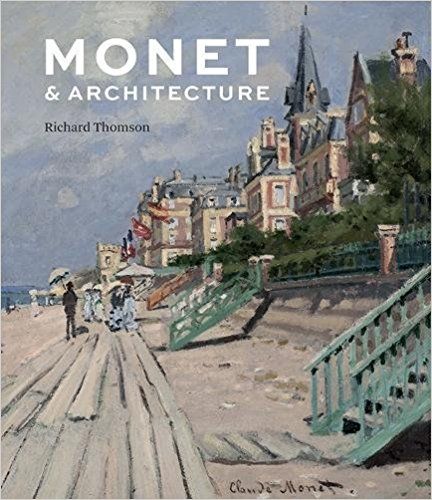
The Credit Suisse-sponsored exhibition Monet & Architecture (Amazon.co.uk, Amazon.com, Amazon.de, Amazon.fr) at the National Gallery in London ends on July 29, 2018. Over 20 years have passed since the last monographic Monet show in the British capital. A good reason to have a closer look at the works of this leading Impressionist painter.
Claude Monet (1840-1926) is best known for his series of roughly 250 Water Lilies (Nymphéas) oil paintings. But his oeuvre goes of course beyond flowers, gardens and landscapes. As guest curator at the National Gallery in London, Richard Thompson, a professor of fine arts at the University of Edinburgh, has put together an impressive show with 77 paintings documenting the artist’s interest in architecture and the built environment. Monet & Architecture documents the frequent, often insistent, sometimes subtle presence of buildings in Claude Monet’s works.
Obviously, the artist’s depictions of cities such as his birthplace Paris as well as London, Amsterdam, Rouen and Venice offer architecture a prominent place. In addition to major tourist attractions, iconic buildings, he also featured modest suburban houses as well as functional architecture such as the Gare Saint-Lazare in his paintings. His oeuvre includes works depicting the cathedral of Rouen as well as a customs officer’s cottage in Normandy.
Richard Thomson acknowledges that Monet was never a topographical or architectural painter. However, the only phase in which architecture had no part in his works was after the exhibition of his Venice canvases in 1912 when he concentrated on his Nymphéas.
For the rest, Monet used buildings in his pictures for all sorts of reasons. They served as records of particular locations, identifying this village by its church, that suburb by its bridge, a city by its celebrated monuments. In addition, architecture offered a measure of modernity, e.g. the glass-roofed interior of a railway station or the iron girders of a bridge a gauge of the industrial and up-to-the-minute. By contrast, a venerable structure of old-fashioned style marked out the historic or the picturesque.
Architecture also aided Monet with formal decisions, the busines of painting, for a designed construction would give a regular shape in the irregularity of nature or a red-tiled roof could offer a complementary contrast to the dominant green of the surrounding vegetation.
The structured or textured surfaces of buildings provided Monet with screens on which light played, solid equivalents to reflections on water. Furthermore, a man-made structure helped engage the spectator with the experience of landscape, duplicating in painting human engagement with the landscape as habitat.
In addition, architecture prompted the suggestive evoaction of mood, whether it be awe at the grandeur of a historical monument or the loneliness at the solitude of the cliff-top cottage.
Buildings frequently played substantial, diverse and unexpectedly regular roles in Monet’s paintings. They opened up a broad palette of possibilities, covering resonance of subject, the crafting of the picture and the reading as well as psychological association.
According to Richard Thomson, painting the built environment was as much part of Monet’s identity as a modern painter as weas his Impressionist technique and group allegiance.
Another thread in the narrative of the curator’s Monet & Architecture exhibition is naturalism. Monet matured in an aesthetic that insisted on painting the material world. However, during his career, he became increasingly conscious that the accuracy and honesty of representation assumed by naturalism was almost impossible to realize because light was constantly changing.
Monet painted buildings transformed by time, wheather, accident, war, age and architects. Therefore, Richard Thomson is approaching Monet’s work via the concept of the picturesque, the contemporary city and great monuments. This challengly brings together the threads of modernity and tourism, naturalism and time.
In three chapters, Richard Thomson focuses on “The Village & the Picturesque”, “The City & the Modern” as well as “The Monument & the Mysterious”. In his conclusion, the author and curator stresses that Monet’s engagement with architecture in his paintings was complex and by no means consistent, but exploring it illuminates significantly our understanding of his work. The picturesque, the modern and the mysterious are recognizable in his work but also subject to ambiguity and transformation.
Monet’s engagement with naturalism later led him to go beyond the recording of physical reality into the most extreme pictorial articulation of atmospheric inconstancy and intangibility. Monet’s use of architecture is extraordinary diverse. The way he painted buildings even helped to record the atmospheric and the ethereal.
Whether you are interested in the curator’s findings or not, 77 major Monet oil paintings are waiting for you at the National Gallery in London.

The exhibition catalogue is the main source for this book review. For an easier reading, quotes and partial quotes are not between quotation marks.
The catalogue: Richard Thomson, ed.: Monet & Architecture, National Gallery, London, 2018, 248 pages. Order the book from Amazon.co.uk, Amazon.com, Amazon.de and Amazon.fr.
The exhibition at London’s National Gallery ends on July 29, 2018.